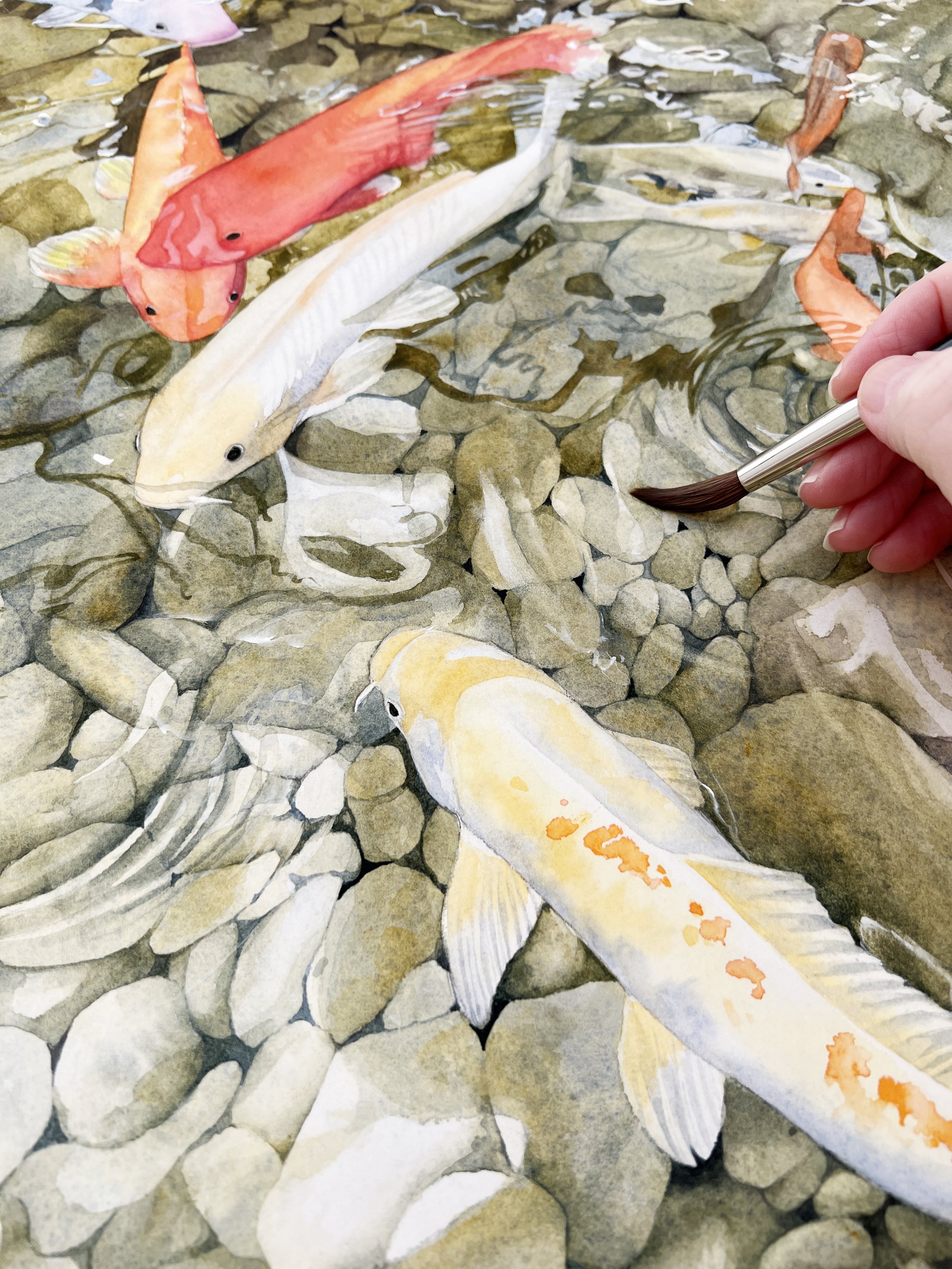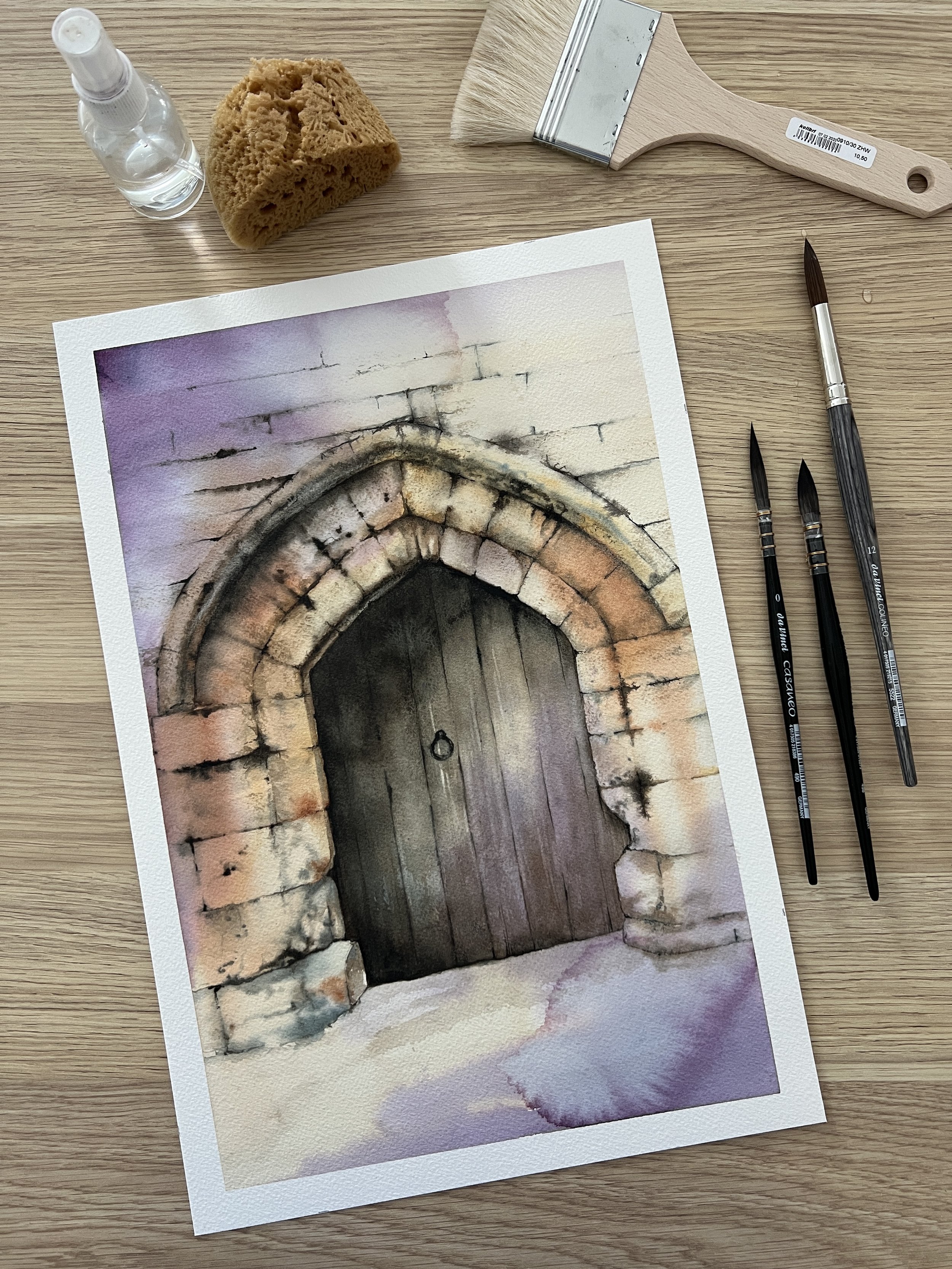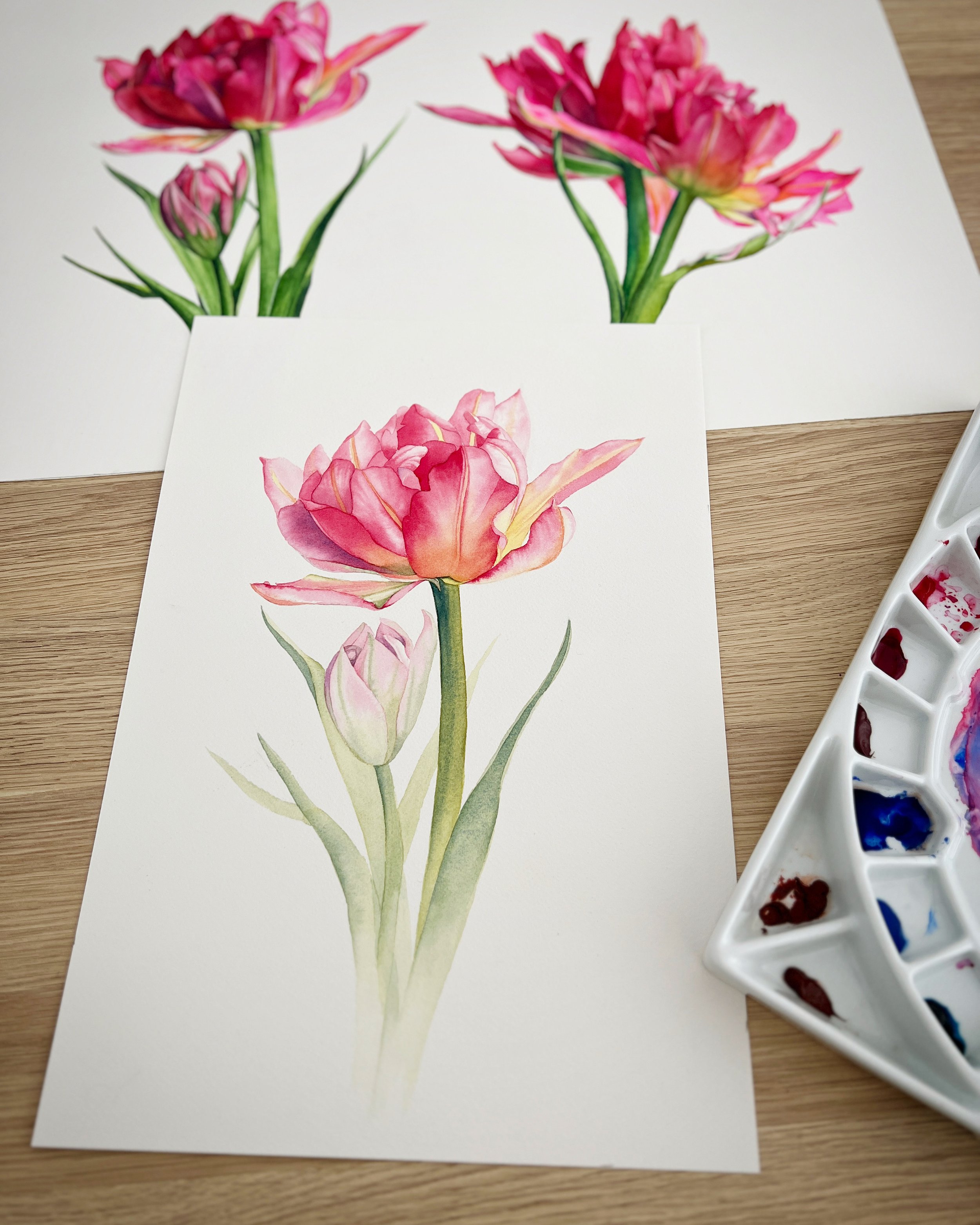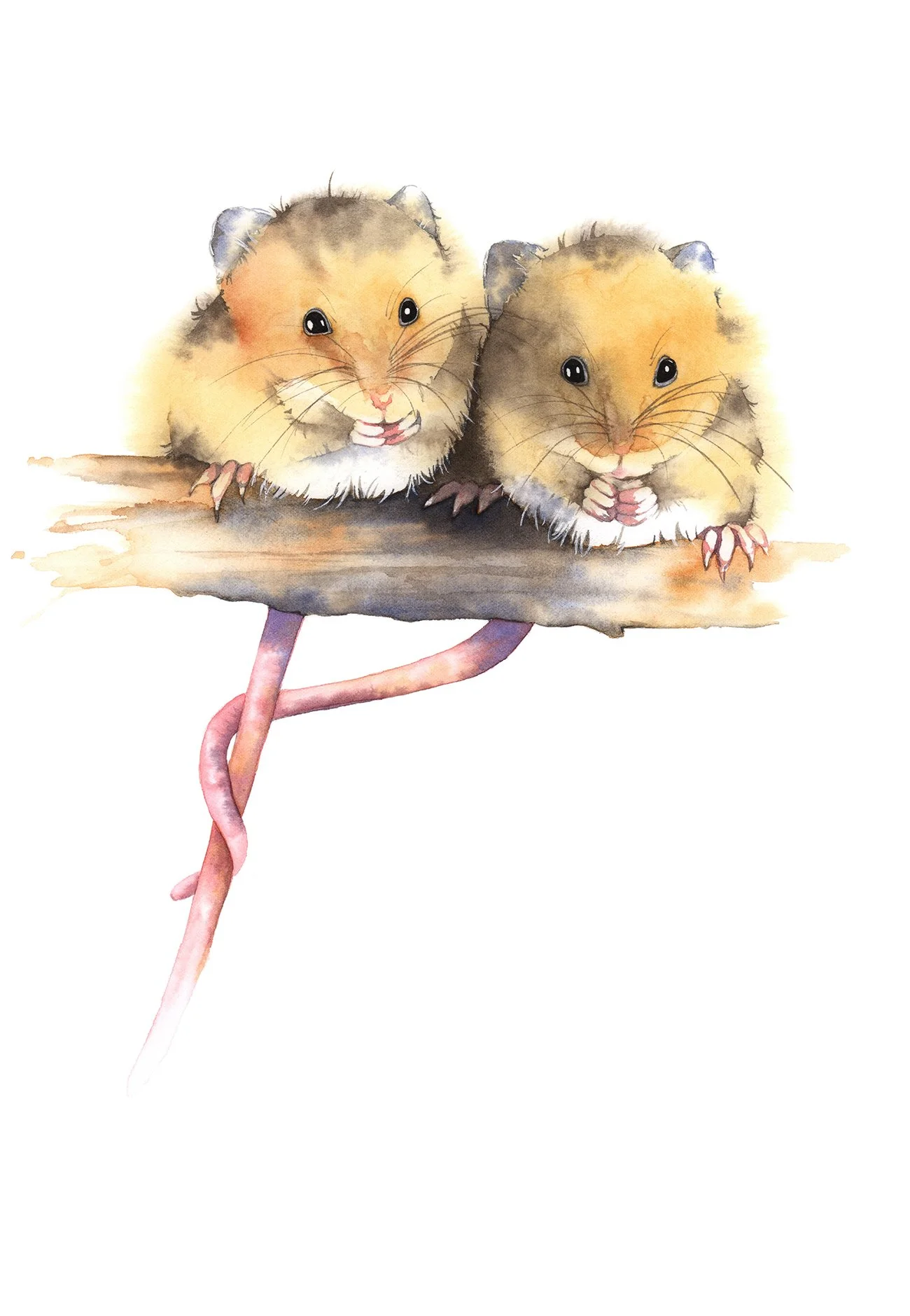Elevate your Art with Watercolour Backgrounds
How basic watercolour techniques can create stunning watercolour backgrounds
In the nuanced world of watercolour art, crafting the perfect background is akin to setting the stage for a gripping narrative. It's not just about filling the space around the subject but about enhancing the overall impact and effectiveness of the visual narrative. Backgrounds are integral elements that contribute depth, context, and emotion, transforming simple compositions into captivating stories. This comprehensive guide dives into the palette of techniques that can elevate your watercolour backgrounds, ensuring they play their crucial role in your artwork's storytelling.
There are lots of decisions to make as a watercolour artist. Should you paint the background or do you leave it unadorned?
How Important is the Background in a Watercolour Painting?
Here on this watercolour painting I add a detailed background of rocks and ripples.
In the realm of watercolour art, the power of a well-crafted background cannot be overstated. Far from being mere backdrops, backgrounds are pivotal in both art and storytelling, weaving depth, context, and emotion into the fabric of the visual narrative. They are the silent storytellers, the unsung heroes that frame our subjects, inviting the viewer into a more profound, immersive experience. Let’s deepen our dive into the art of creating backgrounds that elevate your watercolour paintings to new heights of narrative and aesthetic appeal.
The Role of Backgrounds in Art and Storytelling
Backgrounds in art fill the critical space between the subject and the frame, turning empty canvases into resonant scenes brimming with life. They define the positive (subject) and negative (space around the subject) spaces, adding layers of depth and context. A background can support the main subject with a contrasting or complementary backdrop or even steal the spotlight, as Vincent van Gogh’s “Starry Night” beautifully illustrates. They're not just settings; they're expressions, setting the mood, suggesting settings, and influencing the viewer's emotional response.
Starry Night, though not a watercolour, was all about the background.
A dark, brooding background might whisper tales of sorrow, while a brightly lit backdrop could sing songs of joy and tranquility. Techniques like coherence, contrast, and framing work in concert to enhance the subject and unify the composition, ensuring a harmonious interplay of all elements within the artwork.
Moreover, backgrounds serve as powerful narrative tools, enriching the storytelling dimension of art. They ground the subjects, providing a sense of space and light, and invite viewers to explore the world beyond the focal point. The inclusion of a background, its design complexity, and its interaction with the main subject are vital considerations that dramatically shape the artwork's impact. Through thoughtful backgrounds, artists can transform simple pieces into rich, engaging narratives that captivate and inspire.
Bartolome Esteban Murillo- "Two Women at a Window" 1670. Murillo's painting demonstrates how a darker palette can be utilized not just to evoke a sense of sorrow, but to create depth, highlight the subjects, and invite viewer engagement in a more subtle and nuanced manner.
Claude Monet - "Woman with a Parasol" -Monet's brightly lit backdrop is not just a setting but an integral part of the narrative, highlighting the themes of joy, beauty, and the fleeting nature of moments of happiness. It's a vivid illustration of how light, colour, and technique can come together to create a backdrop that sings songs of joy and tranquility.
Should I Paint the Watercolour Background First or Last?
When painting with watercolours, choosing the right time to paint the background depends on your specific project and the effect you're aiming to achieve. Here are some general guidelines to consider:
If you're aiming for a soft, diffused look for your background, you might want to paint the watercolour background first, using the wet-on-wet technique. This method allows the colours to blend seamlessly on the page, creating a gentle gradient effect. It's ideal for skies, landscapes, or abstract backgrounds.
With this watercolour painting of some Lilies I painted the background first on wet paper.
Here is the completed watercolour painting of the Lilies I painted.
If you prefer a more controlled and detailed background, or if your subject requires sharp contrasts and crisp edges, you might paint the background after the main subject. This technique involves painting on dry paper, allowing for more precision. It's suitable for when you want to avoid colours bleeding into each other, especially if the main subject is already painted and you wish to preserve its integrity.
Watercolour relies on the paper's whiteness to create highlights since it's a transparent medium. If your composition requires bright highlights or white spaces, you might plan your background accordingly. Sometimes, you might even leave the paper untouched in certain areas to preserve the white or apply a masking fluid to protect these spots. You can also lay down a subtle wash first and then preserve this wash with masking fluid.
Watercolour works well in layers. If your piece requires depth, you might start with a lighter wash as the initial background layer, let it dry completely, and then add detailed elements or darker tones. This approach can add complexity and richness to your work.
With this rose painting, I wasn't sure whether I wanted to include a background or not. I completed the rose and made my decision to include a background after I had painted it.
Adding dark backgrounds when you work with watercolour might mean layering the paint until you achieve the desired level of contrast.
The white colour of the petals needed a dark contrasting background.
Ultimately, the choice of when to paint the background in watercolour art depends on your personal preference, the specific demands of the piece you're working on, and the effect you wish to achieve. Some artists prefer to start with the background to set the tone and atmosphere of the piece, while others might paint it last to ensure the main subject dictates the background's form and colour.
Experimentation is key in watercolour painting. Don't be afraid to try different approaches to see what works best for your style and your particular project.
How to Create a Simple Watercolour Background
Simple and basic watercolour techniques can profoundly enhance the background of your artwork, adding depth, texture, and a subtle interplay of colours that can elevate the overall impression. Techniques such as wet-on-wet, where watercolour is applied to damp paper, can create soft colour gradients that mimic the gentle shifts of the sky or the ethereal quality of distant landscapes. On the other hand, the wet-on-dry method allows for more control and definition, perfect for adding detail and contrast to the background elements. Layering thin washes of colour can build up a rich, complex background without overpowering the main subjects.
I demonstrate a few different background ideas in a recent YouTube video.
Watercolour background ideas
A selection of my watercolours where I have incorporated a background.
Blending Brilliance with Wet-on-Wet
The art of blending on wet paper is akin to capturing the seamless transition from dawn to day. This technique allows colours to merge gracefully, creating smooth transitions and gradients that can evoke the right mood and atmosphere for your piece. I just love working with wet washes and wet watercolour paint so much, I have created a blog post with 12 fun ideas that you can do with a wet watercolour wash.
Scumbling and Dry Brushing
Invoke the textured feel of an ancient stone wall or the rugged surface of a distant planet with scumbling and dry brushing. These methods build up layers of colour and texture, adding depth and intrigue to your backgrounds.
Use beautiful colours and create a stunning background with which you can add scumbling and dry brushing techniques.
Salt Effects
A sprinkle of salt on wet paint can create mesmerizing patterns and textures, adding a dash of whimsy and magic to your backgrounds. This simple trick can produce stunning results, ideal for adding intricate details or suggesting otherworldly terrains. I have painted a crimson rosella using that technique for the watercolour background.
Simple splashes of colour with some salt added can create beautiful texture on a background. This is a great idea for beginners.
Using Stencils
For more control and consistency in your background designs, stencils can be invaluable. Whether you're aiming for detailed floral patterns or abstract geometric shapes, stencils offer a way to add complexity and precision to your work.
Splatter Technique and Blowing Through a Straw
Inject dynamism and playfulness into your backgrounds with the splatter technique. Flicking or splashing paint onto the paper captures a sense of movement and texture, perfect for lively scenes or adding an element of unpredictability. You may use a rather stiff old brush for it or a toothbrush.
Another suggestion is to use a short straw. On the background splash below I painted a wet wash of blue and then I blew the wet paint across the paper with a straw, to add some movement.
Blowing the paint through a short straw can be a fun addition to a watercolour painting.
Shadows and Depth
Ground your subjects and add a layer of realism by incorporating shadows. This subtle technique enhances the composition's depth, making your main subject appear more vibrant and anchored in the scene.
Grounding Elements
Providing context and believability, elements like grass or ground beneath your subjects can enhance the narrative, making your scenes more relatable and immersive.
Masking fluid was used to add the long grass in front of the rhinoceros.
Coffee Washes
For an unconventional touch, using coffee as a painting medium can introduce earthy tones and unique textures. This method adds a rustic, organic feel to your backgrounds, creating an interesting visual appeal.
Fade-Out Effects
A soft wash that gently fades into the paper can effectively draw attention to your main subject, ideal for minimalist compositions that require a delicate touch.
No Watercolour Background - Clean and Simple
Sometimes, the most powerful statement is made with simplicity. A clean and simple background can amplify the focus on your subject, showcasing that less is indeed more.
Sometimes you don't need watercolour backgrounds.
Negative Painting Technique
Negative painting is a technique where you paint around the subject rather than on the subject. It's a technique that can add depth and dimension to your paintings. I have written an entire blog post about just this technique.
Crafting Your Canvas: Planning and Execution
The journey to creating impactful watercolour backgrounds begins long before the brush meets the paper. Consideration of your background's role in the overall composition is paramount, setting the narrative and emotional tone for your piece.
Selecting Your Technique
The choice of background technique should harmonize with your subject, enhancing the storytelling without overwhelming. Experimentation is key to finding the perfect match that conveys your intended narrative.
Quality Matters
The materials you choose can significantly affect your artwork's outcome. Investing in high-quality watercolour paper, paints, and brushes can make a substantial difference, elevating your work from good to great.
Embrace Experimentation
Mastery of watercolour backgrounds is a journey filled with discovery. Practice various techniques, explore how different colours interact, and be open to the new effects that experimentation can bring.
Backgrounds in watercolour art are more than just settings; they're a canvas for emotion, context, and depth. By giving them the attention and creativity they deserve, you can turn your watercolour paintings into compelling visual narratives that resonate deeply with viewers. Remember, every stroke, every blend, and every technique you employ is a step towards creating a piece that not only captures the eye but also the heart.
I hope these watercolour background ideas inspire you!
Happy painting! 🎨
If you are interested in learning to paint in watercolour, I have over 170 online, voiced over watercolour tutorials for all skill levels.
Original art, prints and merchandise are available to purchase in the shop.






















